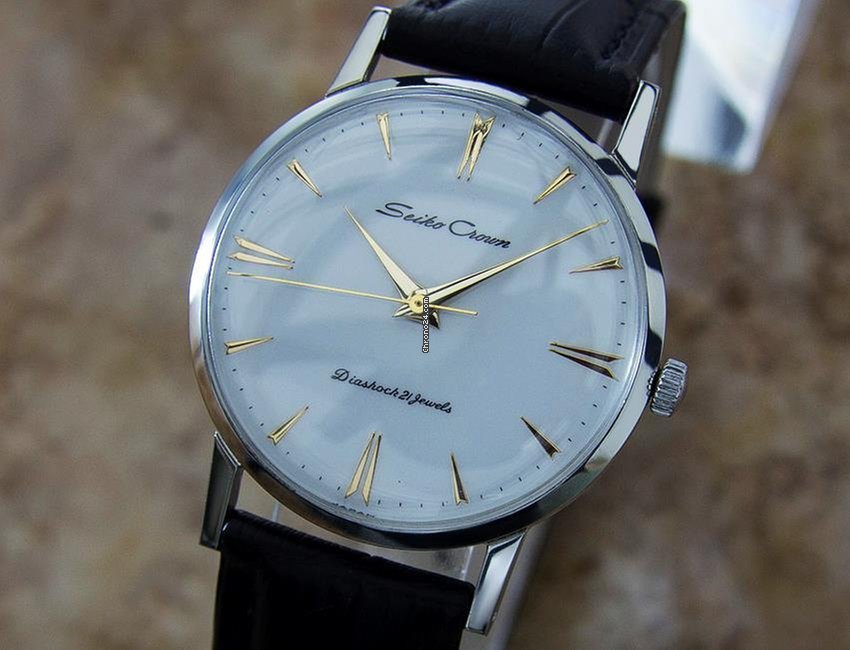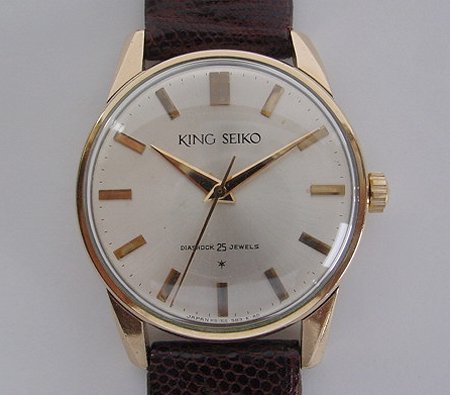Why You Should Care about Vintage Grand Seiko
Why should you care about Grand Seiko? I’ll give you two pretty good reasons: first, its modern watches remain some of the most affordable options out there while still being beloved by watch enthusiasts; second, vintage Grand Seiko remains one of the last undervalued brands in vintage watches (in the West at least), as the vintage watch boom has meant skyrocketing prices for almost all Swiss brands.
Grand Seiko wasn’t even launched internationally until 2010; before that, it was a little cult brand that had slowly leaked its way out of Japan. Up until 2017, Grand Seiko had always been a sub-brand of Seiko, the Japanese conglomerate. Design-wise, this meant the Seiko name and logo at 12 o’clock and the Grand Seiko moniker at 6 o’clock. Reputation-wise, this meant even the most intricately finished of Grand Seikos might still be dismissed as “just a Seiko.”
That all changed in 2017, when Seiko Watch Corp. (SWC) President and CEO Shinji Hattori announced that Grand Seiko would become an entirely separate brand from Seiko proper. At the time — the announcement came at Baselworld 2017 — this was mostly viewed as a re-branding exercise. Now, the Grand Seiko name would sit alone atop the dial, representing that this wasn’t “just a Seiko.” But SWC took this a step further in fall 2018 when it announced that it had created an entirely new and separate company in the United States focused on the sales, marketing, and distribution of Grand Seiko. Named Grand Seiko Corporation of America (GSA), the company is tasked with moving Seiko upmarket. No longer will Seiko’s primary business in the United States be selling low- to mid-priced quartz watches from underneath the jewelry counter at Macy’s. It’s a full-on move into the luxury watch space that the Swiss brands have typically owned — and by the way, it’s the only part of their business that is actually growing. Grand Seiko has already made some headway here, becoming one of the 10 best-selling luxury watch brands in the U.S. in 2018.
As modern Grand Seiko has come into the public consciousness, so too has vintage Grand Seiko. Its vintage pieces can still be hard to find in the Western part of the world, and there are still deals to be had. For enthusiasts looking to dabble into vintage for the first time, Grand Seiko is a great place to start.
That’s enough business talk. We’re here for the watches, specifically the vintage ones. Since Seiko launched the Grand Seiko brand in 1960, they’ve been making some pretty great ones.
1950s Seiko Crown in stainless steel | Chrono24
As the legend goes, in the 1950s there were two Seiko factories: Suwa Seikosha (located in Suwa, Nagano Prefecture) and Dani Seikosha (Dani meaning “second.” Another note on translations: Seiko translates into something like “exquisite/success,” so Grand Seiko means something like “Grand Success.” Subtle). Suwa had been the only factory standing after World War II, and the Dani factory was Seiko’s first effort to rebuild after the war. The two factories were separate entities within Seiko, which supposedly promoted intra-company innovation and competition (gotta love Japanese management methods). Around this time, both factories were tasked with dreaming up a watch that could compete with the luxurious Swiss watches and challenge the perception that Japanese watches, and Seiko watches in particular, were somehow lesser.
The Grand Seiko “First”
This project resulted in Suwa releasing the first Grand Seiko in 1960. This first generation Grand Seiko was called the Grand Seiko model 3180, or Grand Seiko “First.” It was the first chronometer-grade watch produced in Asia, but rather than being certified by the Swiss-based COSC, it was certified internally to standards even more stringent than the COSC’s.
The first Grand Seiko First introduced to the market had the logo carved into the dial, an intense process conducted by hand. Grand Seiko eventually changed to placing a printed logo on the dial. These are the rarest of Grand Seiko First models, and thus the most expensive on the vintage market. Finally, later models (as pictured) have an applied logo. These are the most common, though it should be noted that because the Grand Seiko First was produced only for the Japanese market, and only from 1960-1964, it is rare to find in any form. It is said that only 36,000 Grand Seiko model 3180s were every produced, so considerably less live on in the vintage market.
The Grand Seiko First was produced in 18 karat gold plated cases, with a rare few produced in platinum; all had matching applied markers. The Grand Seiko case back includes a lion logo signifying the internal chronometer rating; it was not a waterproof case. This lion logo would continue to be used until 1966, when the Grand Seiko medallion superseded it. While the design clearly takes cues from the 1950s Seiko Crown (pictured above), it’s a more luxurious take: gold, finely finished, greater wrist presence.
Now, to the legendary movement, where the model 3180 really shines. The Grand Seiko First contained a 25-jewel movement oscillating at 18,000 bph. It was an uncomplicated movement with hours, minutes, and central seconds, but also included a hacking feature, not found on other Seikos for decades.
While Suwa was producing the Grand Seiko model 3180, Daini Seikosha also got in on the luxury game, producing the King Seiko from 1961 to 1964. The King Seiko came in a gold or stainless steel case. Like the Grand Seiko First, it had a 25-jewel manual wind movement. But, it was not internally tested like the model 3180, so it did not receive the “chronometer” designation. Among other factors, this led to the King Seiko being considered a lesser watch. Today, vintage King Seiko is an oddity, and a relatively rare one at that. It is often sought after by collectors for this very reason.
The first King Seiko, produced from 1961-1964. | Timepiece Chronicle
57GS
In 1963, Grand Seiko introduced its second series of watches to the market, the 57GS, nicknamed the “Self Dater” because of the added date function at 3 o’clock. Unlike the Grand Seiko First, the 57GS is most commonly found in stainless steel, followed by cap gold cases that are also made of stainless steel, but covered in a thick gold. Solid 18k gold cases were also made, but are extremely rare.
Three different movements can be found in the 57GS, along with three corresponding case and dial reference numbers:
43999 case back and dial; 430 movement, 18,000 bph
5722-9990 case back and dial; 5722A movement, 18,000 bph
5722-9991 case back and dial; 5722B movement, 19,800 bph
Grand Seiko 5722-9991 | Chrono24
But, you will also find many mix-and-match watches on the market: watches whose case backs don’t match the dials or the movement they’re “supposed” to correspond with. This doesn’t necessarily qualify them as “franken watches.” Most 57GS examples you’ll find will certainly have been serviced over the years, and since many of the pieces on these watches are interchangeable, a servicer could have thrown in whatever he needed to put the watch back together.
The addition of a screw-down crown to the 57GS meant they were now rated to 50 meters of water resistance. All of these movements contained 35 jewels. While the 430/5722A models had dials noting they were a chronometer, the 5722B models had no such notation. But, these 5722-9991 cases are where we first see the Grand Seiko medallion on the case back, replacing the lion that had adorned previous Grand Seiko models. This and the higher beat (now 19,800 bph) may have meant that the 5722B underwent Grand Seiko’s rigorous internal chronometer certification.
The 57GS was produced until 1969.
The Grammar of Design
Around this time, Seiko’s first designer, the now-legendary Taro Tanaka, began to realize how freaking dull Seiko watches were compared to their Swiss competition. He wanted Seiko’s watches to “brilliantly sparkle” like their Swiss counterparts. Tanaka defined a design language, which Seiko termed its “Grammar of Design” that all Grand Seiko watches would follow. This design language still influences modern Seiko and Grand Seiko. It includes:
Double-width index at 12 o’clock
Multi-faceted rectangular indices and hands
Highly polish bezel, planes, and two-dimensional surfaces
Half-recessed crown
Curved sidelines
Zaratsu polishing
After the articulation of this Grammar of Design, Grand Seiko began to flourish as a brand. The unified design language and eventual combining of efforts of the previously competing Daini and Suwa factories meant a wealth of resources for Grand Seiko to begin producing consistently high-quality and beautiful watches.
This began with the production of the 44GS, which set the trend for the modern Grand Seiko style that still exists to this day.
The introduction of the 44GS is where we’ll pick up part 2 of our Brief History of Grand Seiko.
For more on vintage Grand Seiko, check out Seiko’s Grammar of Design: The Art of Impermanence



